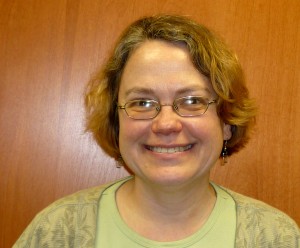 Dr. Penny Rheingans co-directs UMBC's VAnGOGH lab, where she uses her knowledge in data visualization to solve problems in a variety of application areas.
Dr. Penny Rheingans co-directs UMBC's VAnGOGH lab, where she uses her knowledge in data visualization to solve problems in a variety of application areas.
Dr. Penny Rheingans, professor, specializes in data visualization, where the aim is to create visual representations of large amounts of data in order to uncover patterns. “We’re basically using applied computer graphics to create visual imagery which allows people in their visual and cognitive systems to understand the data,” she explains. “I think it’s a really cool area because it allows me to synthesize things from a number of areas,” says Rheingans of the field, which allows her to combine techniques from computer graphics, art and illustration, and knowledge of human perceptual and cognitive systems.
Along with Dr. Marc Olano, Dr. Rheingans co-directs UMBC’s VAnGOGH: Visualization, Animation, Graphical Object Modeling, and Graphics Hardware Laboratory. Instead of constraining her work to a single research area, Dr. Rheingans works on a variety application areas that fall under four main themes: 1) How can you leverage perception, 2) how can you steal good ideas from illustrations, 3) how can you show things that are uncertain or variable, and 4) how can you show things that change over time.
Throughout her research career, Dr. Rheingans has pursued a wide-range of application areas. Some projects include collaborating with Dr. Lynn Sparling, associate professor of physics at UMBC, and her students in order to understand the dynamics that cause hurricanes; working with Deborah Silver, professor of electrical and computer engineering at Rutgers University, in computational fluid dynamics; working with members of the Howard County school system on a redistricting problem; and working on a project for the intelligence community that sought to understand the flow of information through a community by studying research papers, just to name a few.
 In addition, Dr. Rheingans has done research in the field of artistic rendering, both in the computer graphics and the visualization side. Two of her papers on non-photorealistic volume rendering– Volume Illustration: Non-Photorealistic Rendering of Volume Models and Non-Photorealistic Volume Rendering Using Stippling Techniques–won IEEE best paper awards in 2000 and 2002.
In addition, Dr. Rheingans has done research in the field of artistic rendering, both in the computer graphics and the visualization side. Two of her papers on non-photorealistic volume rendering– Volume Illustration: Non-Photorealistic Rendering of Volume Models and Non-Photorealistic Volume Rendering Using Stippling Techniques–won IEEE best paper awards in 2000 and 2002.
Apart from her own research, Dr. Rheingans has worked with graduate students on impressive research projects. Jesus Caban, currently a postdoc at NIH, did work on “statistical morphology,” where he studied anatomical variability of the human brain between subjects with Alzheimer’s and healthy subjects. “Looking at the structure of somebody’s brain in relation to normal variability might be another diagnostic tool for being able to identify people with that condition,” says Rheingans of the project. Another of her students, Alark Joshi, now an assistant professor of computer science at Boise State University, used techniques from comic strips to show motion in order to express motion in volumes from computational fluid dynamics or hurricane simulations.
When asked about her ultimate research goal, Dr. Rheingans responded with a laudable aspiration. “What I’m trying to do with my research is make people smarter,” says Dr. Rheingans, “[to] help them understand big piles of data so that they can make better decisions.”